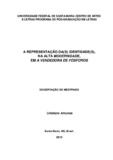| dc.creator | Antunes, Cristiane de Oliveira | |
| dc.date.accessioned | 2015-05-25 | |
| dc.date.available | 2015-05-25 | |
| dc.date.issued | 2015-02-06 | |
| dc.identifier.citation | Antunes, Cristiane de Oliveira. The representation of the identitie(s), of high modernity, in A vendedora de fósforos. 2015. 88 f. Dissertação (Mestrado em Letras) - Universidade Federal de Santa Maria, Santa Maria, 2015. | por |
| dc.identifier.uri | http://repositorio.ufsm.br/handle/1/9920 | |
| dc.description.abstract | The purpose of this work is to analyze the book A vendedora de fósforos in order to identify some literary resources that may be representatives of the personal identities of the historical period known as High Modernity, considering that the book brings in its composition a hodgepodge of exchanging narratives voices, a construct of complex characters due to obscurity of their identities (discursive and personal), a thematic replete of creation and discovery of selfidentity and a temporal organization of the narration without fidelity to the chronological order. In this sense, it will be analyzed the literary and the stylistic resources used by the author in the construction of the characters and narrator(s), and how this process can illustrate the personal identity narratives and what are these identities; similarly, the great formal dilemma of the novel will be examined, which is the issue of the voices and the narrative point of view (interlaced), aiming to infer how this structural dynamism represents the identities of High Modernity. In order to do this, the principles of narratology will be used interwoven with the theories of sociology about these theoretical categories. The entanglement resulting from the (con)fusion of voices that apparently alternate in the narrative point of view leads to believe that there are two narrators in the text. Throughout the analysis, however, It is possible to see that one of the voices (the younger sister) is just a ventriloquist voice, a construction of the real narrator (the older sister), which represents in a significant way the amalgam and the mutual mirroring of the identities of the two sisters, either as discursive as characters, in the plot. | eng |
| dc.description.sponsorship | Coordenação de Aperfeiçoamento de Pessoal de Nível Superior | |
| dc.format | application/pdf | por |
| dc.language | por | por |
| dc.publisher | Universidade Federal de Santa Maria | por |
| dc.rights | Acesso Aberto | por |
| dc.subject | Narrativa | por |
| dc.subject | Personagem | por |
| dc.subject | Identidade | por |
| dc.subject | Alta modernidade | por |
| dc.subject | Narrative | eng |
| dc.subject | Character | eng |
| dc.subject | Identity | eng |
| dc.subject | High modernity | eng |
| dc.title | A representação da(s) identidade(s), na alta modernidade, em A vendedora de fósforos | por |
| dc.title.alternative | The representation of the identitie(s), of high modernity, in A vendedora de fósforos | eng |
| dc.type | Dissertação | por |
| dc.description.resumo | Este trabalho tem como proposta analisar o romance A vendedora de Fósforos com o objetivo de identificar alguns recursos literários que podem ser representativos das identidades pessoais do período histórico conhecido como alta modernidade, considerando-se que o livro traz, em sua composição, uma miscelânea de vozes narrativas cambiantes, um construto de personagens complexo devido à obscuridade de suas identidades (discursivas e pessoais), uma história que traz claramente, em sua composição, o processo de criação e descobrimento da autoidentidade e uma organização temporal da narração sem fidelidade à ordem cronológica. Nesse sentido, analisar-se-ão os recursos literários e estilísticos utilizados pela autora na construção das personagens e narradora(s) e como este processo pode estar representando as narrativas identitárias pessoais do sujeito da alta modernidade e que identidades são essas; da mesma forma, será examinado o grande dilema formal do romance, que é a questão das vozes e focos narrativos (entrelaçados), objetivando inferir como esse dinamismo estrutural está representando as identidades da alta modernidade. Para isso, serão utilizados os princípios da narratologia entrecruzados com as teorias da sociologia acerca dessas categorias teóricas. O enredamento que resulta da (con)fusão das vozes que aparentemente alternam-se no texto leva a acreditar que existem duas narradoras. Ao longo da análise, no entanto, percebe-se que uma das vozes (a da irmã mais nova) é apenas uma voz de ventríloquo, uma construção da real narradora (a irmã mais velha), que representa de forma significativa o amálgama e espelhamento mútuo das identidades das duas, tanto discursivas (quem é, afinal, a narradora, ou seriam ambas?) quanto como personagens (quem são, efetivamente, essas irmãs na ficção?). | por |
| dc.contributor.advisor1 | Umbach, Rosani Úrsula Ketzer | |
| dc.contributor.advisor1Lattes | http://lattes.cnpq.br/5773862679226891 | por |
| dc.contributor.referee1 | Pereira, André Luis Mitidieri | |
| dc.contributor.referee1Lattes | http://lattes.cnpq.br/5629822206205508 | por |
| dc.contributor.referee2 | Oliveira, Raquel Trentin | |
| dc.contributor.referee2Lattes | hhttp://buscatextual.cnpq.br/buscatextual/visualizacv.do?id=K4764348U6 | por |
| dc.creator.Lattes | http://lattes.cnpq.br/0937109345015283 | por |
| dc.publisher.country | BR | por |
| dc.publisher.department | Letras | por |
| dc.publisher.initials | UFSM | por |
| dc.publisher.program | Programa de Pós-Graduação em Letras | por |
| dc.subject.cnpq | CNPQ::LINGUISTICA, LETRAS E ARTES::LETRAS | por |


